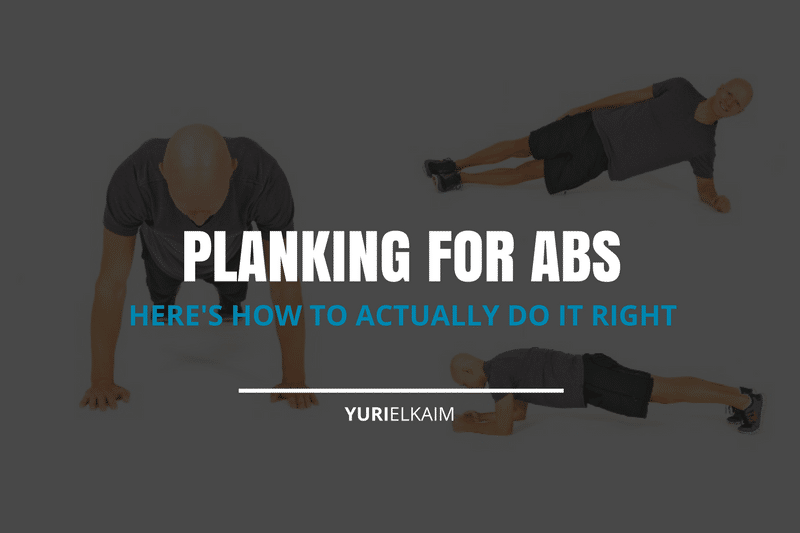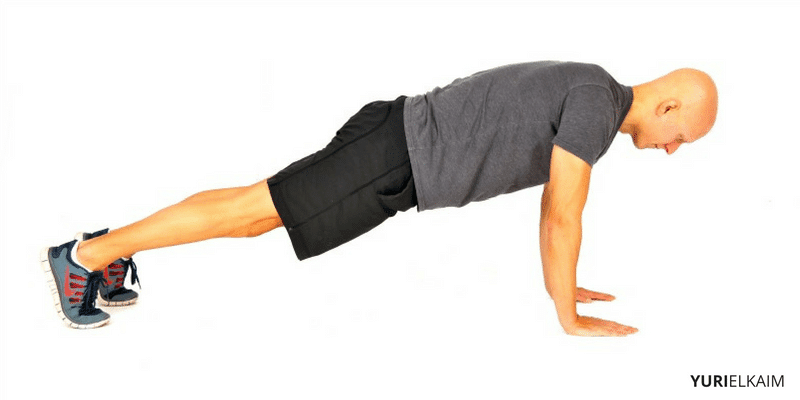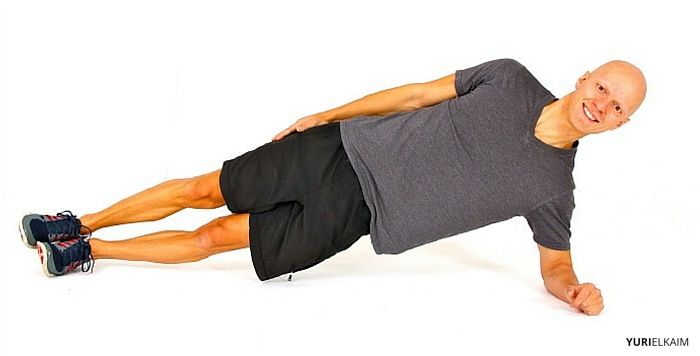If you haven’t been planking for abs, shame on you.
In this article
Okay, I’m only kidding … sort of.
Joking aside, planks have received a lot of attention in the past few years, and for good reason. Their list of benefits is extensive and, surprisingly, includes more than just achieving a tight, toned core and six-pack.
Unfortunately, many people don’t understand how much power planks have when it comes to building strong abs. That’s because they’ve tried them and haven’t seen results.
Which would obviously lead you to wonder, if planks are so amazing, why aren’t people seeing results?
The answer is simple:
Incorrect form.
Form is everything when it comes to seeing results from planks, and if you don’t get the perfect form down with the standard plank, you can forget about seeing results doing any of its variations.
Below I’ll show you what this perfect form looks like and how to achieve it. And don’t worry if you’re an absolute beginner – there are several ways to work up to doing a full plank.
And trust me, you’ll be glad you did.
Planking for Abs
Planks are one of those exercises everyone should be doing, regardless if you care about having a six-pack or not.
This is because the benefits of this exercise run far deeper (literally) than just the front of our bellies.
Let’s start with the obvious: planks are one of the best core exercises you can do to tighten your core.
Yes, they’re even better than crunches.
Why? Because crunches don’t actually work the core.
You see, our core includes many more muscles than just those that comprise our “six-pack.” It includes the entire area from the front of our stomach and wraps all the way around our lower back.
Your Core Muscles
This includes the rectus abdominus (the six-pack ab muscles), the internal and external obliques (the muscles that run down the side of your torso), the transverse abdominus (the innermost layer of muscle around your spine), the hips, and the low back.
Crunches ignore most of these muscles, focusing solely on the rectus abdominus (six-pack). This can create “ripped” abs, sure, but ultimately still leaves the core weak.
Planks, on the other hand, strengthen not only the six-pack muscles, but also each of the surrounding muscles in your abdomen.
This translates into what I like to call the “corset” effect, where the inner muscles of the core zip everything up into a tight and toned torso package.
Still not convinced? Studies show crunches really do engage fewer core muscles than exercises that recruit “deltoid and gluteal” muscles, like planks (1).
This brings me to the next reason you need to start planking for abs:
Planks Don’t Stop at the Core
In reality, planks are a full-body exercise. Every muscle from your shoulders to your calves and glutes is engaged as you hold yourself suspended above the ground.
Since form is so important when we perform planks, they also end up being excellent for improving posture.
They Help Prevent Injury
Remember how we talked about planks strengthening those deep inner core muscles – specifically the transverse abdominus?
This muscle is not only responsible for tightening our core but also for supporting and cushioning the spine. Many forget that this is the true function of our core and abdominals in the first place: to prevent unnatural twisting and bending of the spine and disks.
Compare this to crunches, which actually place the spine in a dangerous position. The unnatural compression as you lift up and down creates stress and pressure on the lower part of the spine, setting the stage for spinal injuries (or, at the very least, low back pain).
So as you can see, planks would be the logical exercise choice if you were looking to strengthen your core while also improving low back pain and preventing further spinal stress.
Plus, planks strengthen our center of movement, improving mobility and stability. A supported spine and strong core make any movement easier, while also helping us maintain better balance.
This equals less risk for falls and can even increase performance.
An interesting study reiterated this, showing that 25 scoliosis patients practicing side planks for 10 to 20 seconds at least once a day reduced spinal curvature (2).
Planking for Abs How-Tos
At first glance, planks look simple.
After all, propping yourself up on your elbows for a few seconds can’t be that complicated, or difficult, right?
Don’t be deceived. I’ll let you decide after you try a few planks the right way. Hint: there’s a reason they’re so effective.
Proper plank form involves much more than simply resting on your elbows and toes.
Below I’ll break down what you should and should not be doing during a plank. The good news is, focusing on your form makes the seconds tick by a little faster!
Don’t:
- Sag your hips toward the floor.
- Push your butt in the air.
- Drop your head toward the floor.
Do:
- Keep your spine in a straight line from head to toe.
- Engage your glutes.
- Tighten your abs.
- Keep your elbows directly beneath your shoulders.
- Keep your shoulder blades back and down.
- Hold for 30 to 60 seconds.
An additional tip: if you’re feeling the tension and burn in your arms and lower back, instead of your abs and glutes, your form is wrong. If you need to, try to practice in front of a mirror in your gym to make sure everything is in line.
Planks for Beginners
Above we looked at proper plank form for the standard plank. But what if you’re an absolute beginner?
One of the reasons planking for abs is so great (aside from its effectiveness) is the fact that planks are so versatile. Check out the variations below you can use to build up to a full plank:
Plank on Knees
- Use a mat or towel to rest your knees on as you come to all fours.
- Step your hands out until you’re in a modified plank position, hands directly beneath your shoulders and elbows in.
- Engage your stomach and glutes, holding for 15 to 30 seconds.
- Perform three rounds of 15 to 30 second holds.
High Plank (Push-up Position)
- Get into a pushup position, hands beneath your shoulders and body in a straight line from head to toe.
- Engage your glutes, keep your elbows in, and hold for 15 to 30 seconds.
- Perform three rounds of 15 to 30-second holds.
Once you’re easily holding the high plank for more than 30 seconds, you can move on to standard planks on your elbows.
At this point, you can also try outside planks for more variation.
Side Plank
- Begin in a standard plank position, elbows directly beneath your shoulders.
- Roll to one side, lifting your outside arm toward the sky and opening your chest.
- Keep your hips lifted and stack one foot on top of the other.
- Hold for 15 to 30 seconds, then switch sides. Repeat for three rounds.
Now, if you’ve made it this far and are up for more challenging plank variations, check out this post for 11 more.
Frequently Asked Questions (FAQs)
Do you still have more questions about planking for abs? Check out some of the most commonly asked questions about this topic below.
How often should I do planking to see results on my abs?
Planking every day can help to strengthen and tone your core muscles. However, it’s also important to include variety in your workout routine for the best results. A well-rounded fitness routine can help to target different muscle groups and prevent overuse injuries. Consider adding planks into your routine 3-5 days per week, holding the plank position for as long as you can while maintaining good form.
What is the correct form for a plank?
To start, place your hands directly under your shoulders (like you’re about to do a push-up). Ground your toes into the floor and squeeze your glutes to stabilize your body. Keep your neck and spine neutral, looking at a spot on the floor ahead of your hands. Avoid arching your back or letting your body sag down; your body should form a straight line from head to heels.
Is planking alone enough to get a six-pack?
While planks are a great exercise for engaging your entire core and can help develop your abdominal muscles, they are not the only exercise you should rely on if you’re looking to get a six-pack. Other factors like nutrition, overall body fat percentage, and additional forms of exercise play significant roles. Incorporate a balanced diet and regular cardio exercise into your routine to help reduce body fat, and consider other ab exercises like crunches, bicycle crunches, and leg raises for more focused toning.
Core Power
There are so many plank variations out there, you’re almost guaranteed to never get bored.
The core strength you’ll gain from integrating planks into your routine will also translate over into any other movement you do, whether it’s gardening at home or doing heavy deadlifts at the gym. Not to mention, your body will be safer in any situation requiring movement.
Sculpt Those Abs
Want to blast the fat away from your belly and reveal that strong six-pack?
Discover 7 unknown ways to lose stomach fat and get flat, toned abs – for FREE!
Download my Abs Secret blueprint and get started today. Just click the banner right now and it’s yours!





